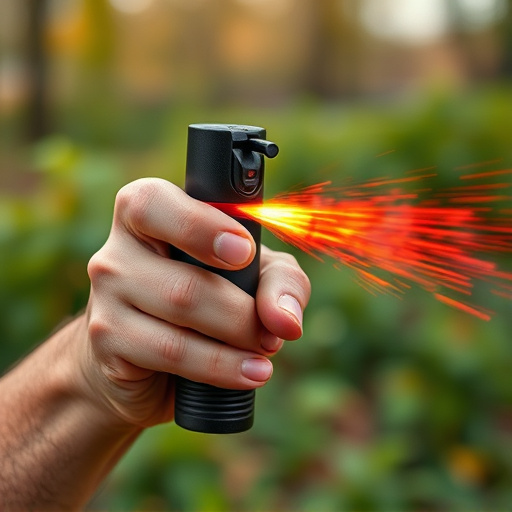In crowd control, pepper spray, a non-lethal law enforcement tool using capsaicin from chili peppers, is deployed strategically to neutralize individuals temporarily. For both officers and civilians, neutralizing face exposure involves immediate 15-minute water rinsing, protective gear like gas masks or face shields, using wet cloths for faster relief, staying calm, and prompt medical attention if breathing or vision is affected, due to pepper spray's potent effects.
In today’s diverse and sometimes volatile social landscapes, understanding crowd control tactics like pepper spray deployment is paramount for both law enforcement and civilians. This article delves into the intricate world of pepper spray, exploring its composition, police strategies, and safe handling practices. We also uncover effective techniques to neutralize pepper spray on the face, a crucial skill for responding to unexpected exposure. By equipping ourselves with this knowledge, we contribute to safer communities.
- Understanding Pepper Spray: Its Composition and Effects
- Police Strategy: When and How to Deploy Pepper Spray
- Safely Handling Pepper Spray: For Both Law Enforcement and Civilians
- Neutralizing Pepper Spray on the Face: Effective Techniques and Countermeasures
Understanding Pepper Spray: Its Composition and Effects
Pepper spray, a powerful crowd control tool used by law enforcement, is designed to temporarily incapacitate individuals through irritant chemicals. Its primary active ingredient is capsaicin, the same compound responsible for the heat sensation in chili peppers. This compound binds to nerve endings, causing a burning feeling and significant discomfort, leading to tears, coughing, and difficulty breathing.
When deployed, pepper spray creates a cloud of oily mist that can remain effective for several minutes. In cases where individuals face physical threats or are resistant to other control measures, pepper spray offers a non-lethal means to neutralize and subdue them. Understanding its composition and effects is crucial for both law enforcement officers and individuals seeking to protect themselves against such irritants, emphasizing the importance of knowing how to effectively neutralise pepper spray on the face.
Police Strategy: When and How to Deploy Pepper Spray
When faced with crowd control situations, pepper spray is a tool police often employ to disrupt and disperse gatherings that pose potential threats or violations of the law. The strategic deployment of this chemical agent requires careful consideration to ensure public safety and minimize harm. Officers are trained to use it as a last resort when other non-lethal methods have failed or are unlikely to be effective.
The process involves aiming for specific target areas, primarily the face, eyes, nose, and mouth. This is because pepper spray irritates these sensitive organs, temporarily neutralizing the individual’s ability to see, breathe, and move effectively. Police officers must adhere to strict protocols, ensuring they have a clear line of sight and are at a safe distance from bystanders to prevent accidental exposure or misuse. Proper training ensures officers know when and how to deploy it, striking a balance between crowd control and public safety.
Safely Handling Pepper Spray: For Both Law Enforcement and Civilians
Neutralizing Pepper Spray Exposure
In crowd control situations, pepper spray is deployed to temporarily incapacitate individuals and restore order. However, safe handling is paramount for both law enforcement officers and civilians alike. After exposure, it’s crucial to quickly neutralize the pepper spray on the face and body. For law enforcement, this involves wearing protective gear and using specialized decontaminant solutions. Civilians should seek immediate shelter and rinse exposed areas with large amounts of water for at least 15 minutes.
Proper neutralization can alleviate symptoms and prevent complications. While professionals have access to advanced decontamination methods, civilians can manage the situation by maintaining calmness, avoiding rubbing eyes or mouth, and thoroughly washing clothing that may still retain spray residue. Regular handwashing and cleaning of affected surfaces are also essential steps in minimizing the impact of pepper spray exposure.
Neutralizing Pepper Spray on the Face: Effective Techniques and Countermeasures
Pepper spray, a common crowd control tool used by law enforcement, can cause significant discomfort and even blindness if it comes into contact with the eyes or face. When neutralizing pepper spray on the face, time is of the essence. The first step is to immediately flush the affected area with clean water for at least 15 minutes, ensuring all traces of the chemical are removed. This initial rinse helps to dilute and wash away the irritants.
Countermeasures such as wearing protective gear, including a gas mask or a tight-fitting face shield, can significantly reduce the impact of pepper spray. Additionally, knowing the proper techniques to remove it, like using a wet cloth to gently rub the skin or eyes, can help alleviate symptoms faster. It’s crucial to stay calm and seek immediate medical attention if breathing becomes difficult or vision is impaired, as these could be signs of more severe exposure.
Pepper spray, while a powerful tool for crowd control, requires careful consideration and responsible handling. Understanding its composition and effects, as well as effective neutralizing techniques like those detailed in this article, are essential for both law enforcement and civilians. By adhering to safe deployment strategies and implementing prompt countermeasures, such as washing eyes and skin with water, individuals can minimize discomfort and avoid more serious consequences. Remember, knowledge is the best defense; staying informed about pepper spray’s capabilities and limitations empowers everyone to navigate potentially charged situations with greater confidence and safety. To effectively neutralize pepper spray on the face, it’s crucial to employ the techniques discussed, ensuring clarity and comfort in challenging circumstances.
